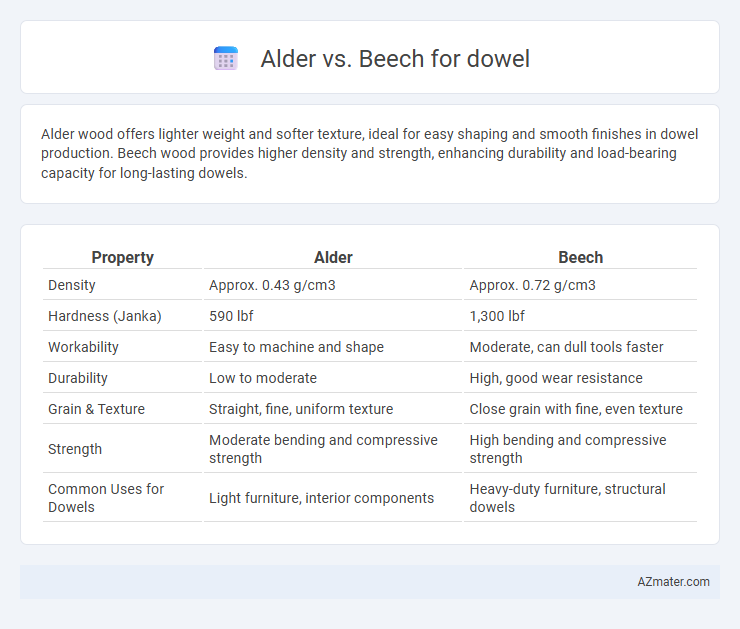Alder wood offers lighter weight and softer texture, ideal for easy shaping and smooth finishes in dowel production. Beech wood provides higher density and strength, enhancing durability and load-bearing capacity for long-lasting dowels.
Table of Comparison
| Property | Alder | Beech |
|---|---|---|
| Density | Approx. 0.43 g/cm3 | Approx. 0.72 g/cm3 |
| Hardness (Janka) | 590 lbf | 1,300 lbf |
| Workability | Easy to machine and shape | Moderate, can dull tools faster |
| Durability | Low to moderate | High, good wear resistance |
| Grain & Texture | Straight, fine, uniform texture | Close grain with fine, even texture |
| Strength | Moderate bending and compressive strength | High bending and compressive strength |
| Common Uses for Dowels | Light furniture, interior components | Heavy-duty furniture, structural dowels |
Introduction to Alder and Beech as Dowel Materials
Alder and beech are popular hardwood choices for dowel production due to their strength and workability. Alder offers a fine, uniform grain and moderate density, making it easy to shape while maintaining durability. Beech provides exceptional hardness and resistance to wear, ensuring strong, reliable dowels for furniture and joinery applications.
Physical Properties of Alder vs Beech Wood
Alder wood is softer with a Janka hardness of about 590, making it easier to machine and less prone to splitting during dowel insertion, while Beech wood has a higher hardness rating of approximately 1,300, offering superior strength and wear resistance. The density of Alder ranges around 420 kg/m3, providing lightweight dowels, whereas Beech's density is significantly greater at approximately 720 kg/m3, contributing to more robust and durable connections. Both woods have close grain structures, but Beech's tighter grain enhances its resistance to compression, making it preferable for load-bearing dowels.
Durability and Strength Comparison
Alder wood offers moderate durability with a Janka hardness of around 590, making it softer and less resistant to wear than Beech, which has a higher Janka hardness of approximately 1,300, indicating superior strength and toughness. Beech's dense grain structure enhances its load-bearing capacity and resistance to compression, ideal for dowel applications requiring robust performance. Alder dowels may be suitable for light-duty uses, but Beech dowels provide greater longevity and strength in demanding woodworking projects.
Workability and Machining Differences
Alder offers superior workability for dowel applications due to its softer texture and uniform grain, enabling smoother cutting and less tool wear compared to Beech. Beech's harder, denser structure provides greater strength but requires more effort during machining, often leading to increased tool dulling and longer processing times. The choice between Alder and Beech hinges on balancing ease of fabrication with the desired mechanical durability of the dowel.
Cost and Availability of Alder and Beech Dowels
Alder dowels are generally more affordable and widely available in North America due to the tree's rapid growth and sustainable harvesting practices. Beech dowels tend to be more expensive, reflecting the wood's increased density and durability, as well as its higher demand in European markets. Availability for beech is often regionally limited, causing fluctuations in price and supply compared to the consistently abundant alder dowels.
Appearance and Aesthetics
Alder wood features a straight grain with a fine, even texture, offering a warm, reddish-brown hue that darkens with age, making it ideal for furniture and decorative dowels seeking a subtle yet rich appearance. Beech wood displays a pale cream color with a slightly pink or brown hue and a tight, uniform grain, providing a clean, smooth aesthetic well-suited for visible dowels in light or natural finishes. Both woods polish well, but beech's consistent grain pattern tends to create a more refined, modern look, whereas alder's natural color variations contribute to a rustic, handcrafted appeal.
Finishing and Staining Capabilities
Alder wood offers a smooth, fine grain that readily accepts stain and finishes, producing warm, even tones ideal for furniture dowels requiring a uniform look. Beech exhibits a harder, tighter grain with excellent finishing qualities, allowing for a smooth surface that holds paint and stain well but may produce slightly less vibrant hues than Alder. Both woods are durable, but Alder's stain absorption enhances color depth, while Beech provides a more consistent and clean finish for dowel applications.
Environmental Impact and Sustainability
Alder wood is sourced from faster-growing trees, making it a more sustainable choice with lower environmental impact due to reduced deforestation rates compared to beech, which grows slower and often results in higher carbon sequestration loss when harvested. Beech dowels, while denser and more durable, typically require longer rotation periods and intensive forestry management, potentially leading to habitat disruption and soil erosion. Choosing alder dowels supports sustainable forestry practices with quicker renewability and lesser ecological footprint.
Best Applications for Alder vs Beech Dowels
Alder dowels excel in lightweight furniture and interior trim due to their softness and easy machinability, making them ideal for delicate joinery requiring minimal expansion. Beech dowels, known for their hardness and strength, are best suited for structural applications such as chair legs, cabinetry, and flooring where durability and resistance to wear are critical. Choosing between alder and beech dowels depends on the load-bearing requirements and desired finish, with alder favoring decorative elements and beech optimized for robust, long-lasting joints.
Conclusion: Choosing the Right Wood for Your Dowels
Alder offers lightweight durability and smooth machining ideal for indoor dowels, while Beech provides superior strength and wear resistance suited for heavy-duty or structural applications. Selecting the right wood depends on the dowel's intended use, with Beech favored for load-bearing joints and Alder preferred for easy handling and fine finishes. Consider moisture resistance, grain tightness, and overall hardness to ensure the dowel's longevity and performance in your woodworking project.

Infographic: Alder vs Beech for Dowel
 azmater.com
azmater.com